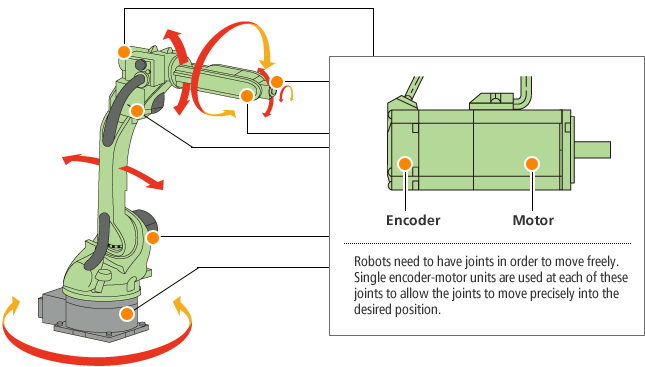Encoder Business

Japan is sometimes called the land of robots. A typical example is the industrial robot. In production lines for automobiles for instance, industrial robots perform around the clock. Service robots too, such as those that clean and those that give directions, are being increasingly put into practical use in a variety of areas. Researchers and developers for one of these—the nursing robot—are hurrying ahead of the imminent super-aging society. As technology has evolved, there is no doubt that society has already begun to take steps toward people and robots living in symbiosis.
The Encoder Business Promotion Division supplies robot manufacturers and motor manufacturers with a wide range of position sensors for controlling robots. These are called "encoders."
Most robots have joints similar to humans, and being able to detect the angles of these joints with accuracy affects the movement of the robot. An encoder is used on each joint of the robot as a sensor to sense these pivotal angles.
Nikon's encoders are used extensively in industrial robots and service robots. One of these is the MAR-M40A, and with this product, we have set the global benchmark for thinness among encoders of similar specifications. The MAR-M40A is used by many customers who comment, "We wanted to achieve high-precision robot movement, but we only had limited space into which to fit the encoder."


MAR-M40
Motors need a large capacity in order to generate more power. Therefore, in order to make robots smaller and to derive greater power, encoders need to be smaller in size.
With the MAR-M40, we successfully achieved a thinner encoder, by adopting a reflective optical system for the optical detection system inside the encoder, and by conducting countless technological tests and making numerous improvements, including efforts to enhance the performance and to increase the integration of electronic circuits. As a result, more and more robots and motors are using Nikon's encoders.
By working to further enhance the performance and reliability of encoders, we will continue to support both the evolution of industrial robots that underpin manufacturing in Japan and the evolution of service robots that care for our aging society.



